#large selection of perennials
Explore tagged Tumblr posts
Photo
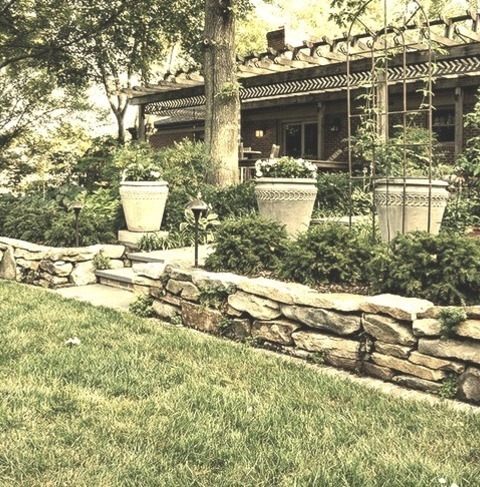
DC Metro Retaining Walls Photo of a mid-sized traditional partial sun backyard stone retaining wall landscape in summer.
#permeable paving#boulders#stacked stone cairn#andy goldsworthy homage#stonehenge homage#large selection of ground covers#large selection of perennials
0 notes
Photo
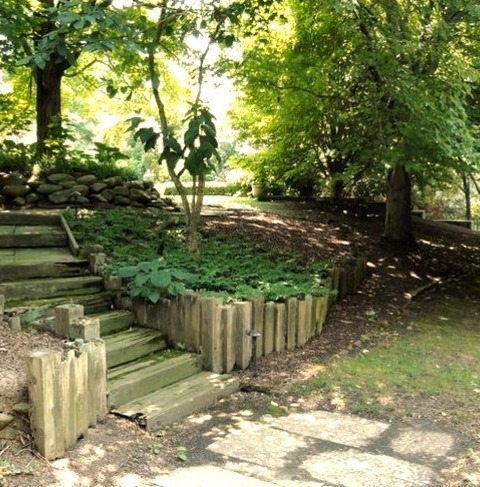
Landscape DC Metro Summertime photo of a medium-sized, traditionally landscaped backyard with partial sun.
#underground rain water storage system#drystone wall#vegetables and herbs in containers#irrigation from collected rain water#large selection of perennials#standing stone boulders
0 notes
Photo

Traditional Landscape - Landscape Photo of a mid-sized traditional partial sun backyard stone water fountain landscape in summer.
#wooden deck#large selection of perennials#pot flower garden#vegetables and herbs in containers#irrigation from collected rain water#stacked stone cairn
0 notes
Photo

Traditional Landscape in DC Metro Photo of a huge traditional partial sun backyard stone landscaping in spring.
0 notes
Photo

Traditional Landscape - Natural Stone Pavers picture of a sizable, classic, partially-shaded backyard with stone landscaping in the spring.
#spring garden#large patio#huge plant selections#spring bulbs#raised patio#stepping stone paths#perennials
0 notes
Text

A sample of common crops of Uanlikri, with a focus on crops grown on the Ojame archipelago.
More information under the cut.
Grains
Several types of grains and grain-like crops are cultivated in Uanlikri. Of these, the four major types are millet, sand rice, swamp rice, and amaranth (not depicted).
Millet and sand rice are heat-loving and drought tolerant, with sand rice requiring especially good soil drainage but being more cold hardy. They are the main staples north of the Kantishian Mountains. Millet is favoured in the wetter Basin region, and sand rice in the dryer, more mountainous western regions, and both are grown equally in the continent's hot and arid northern desert.
Swamp rice is another important staple of the Basin region: though cultivation is complexified by its extremely heavy water requirements (swamp rice only grows in marshes or riverbanks), the complex river deltas leading to the Basin's inner seas are ideal for its cultivation and have been heavily modified to create artificial wetlands where swamp rice can be grown. Some strains of swamp rice have good cold hardiness allowing them to be grown south of the Kantishian Mountains. Swamp rice has also been selected for salt resistance: it is an especially important crop in the cold brackish marshes of the Cianji river and in the hot saltwater marshes of the Ojame Archipelago.
Amaranth is primarily cultivated in southern regions of Uanlikri. In the southern Basin region, they are a supplemental crop, but up in the mountains and in the cold lands south of the Kantishian, amaranth is the main staple. Mountain amaranth is especially frost resistant and able to survive nightly summer frosts in the Kantishian's high plateaus.
Red oats, known in the Ojame archipelago as uciwici, is a locally important crop grown in eastern coastal regions. Red oats is sensitive to extreme temperatures and does poorly in continental climates, but its extremely high salt resistance and ability to grow in poor soils make it a crucial crop by allowing cultivation to extend to otherwise marginal areas such as sandbars, coastal dunes, and other poor, rocky and sandy soils. It is appreciated for its purple grains with a naturally slightly salty taste, and for its decorative red foliage which retains some of its colour when dried, making it useful for basketry.

Ferns
Other grain-like crops grown in Uanlikri are seed ferns. Seed ferns are distantly related to true ferns and cycads. Two species are cultivated in Uanlikri: a climbing seed fern grown South of the Kantishian and which produces large numbers of small orange seeds attached to the underside of its fronds, and a caytoniale tree fern which produces modified fronds with large, round yellow seeds instead of leaves and is grown in the Upper Basin and Great Lakes region.
Climbing seed ferns are extremely prolific with a seasonal harvest on par with grain fields and well-keeping seeds with high nutritional value. The seeds are bitter with a taste somewhat reminiscent of burnt almonds and citrus peel, and are usually parboiled before cooking to remove some of the bitterness.
Caytoniale seed ferns are less prolific but are perennials. The seed envelope is also quite bitter, but the seed flesh has a pleasant neutral flavour and a crunchy, sticky texture not unlike that of meringue. Seeds keep well on the tree, but go bad quickly once harvested unless they are properly processed: seeds meant to be kept are parboiled, smoked, and ground into flour, while seeds meant for short-term consumption are either hulled and ground into flour, or hulled and grilled, often to be eaten as snacks alongside grilled insects.
True ferns are commonly consumed as greens, especially young fern shoots (fiddle-heads) and equisetum (horsetail) ferns. Antioles are less sensitive to the toxins in ferns, and parboiling of fiddleheads is often done but not strictly necessary unless consumed in great quantities.
Legumes
Legumes grown for food are historically rather rare in Uanlikri prior to the conquest of the Western Peninsula by the Senq Ha Empire. There are only two important legume crops in Uanlikri which are native to the continent: the grosbean, and the wax pea.
Grosbean is a vine which produces short, rectangular pods containing two to three large beans. The beans are exceptionally large, very colourful, and have a somewhat chalky texture. They used to be a staple in the Basin region, but have been mostly displaced by more palatable varieties introduced by Senq Ha colonists, though they are still grown for jewellery.
The wax pea is short, somewhat vine-like plant producing smooth pods containing a single unpalatable, extremely waxy pea. Though they are edible under duress, wax peas have never been grown as a food crop. They are instead highly valued for the wax which can be obtained by boiling the peas in a slightly acidic solution.
Other legumes (not depicted) have grown in popularity in the two centuries since and are now commonly eaten in most regions.
Roots and fruits
There is a great regional variation in the crops grown for their greens, roots, and fruits. This section should be treated as a sample of a sample, focused more closely on crops grown in the Ojame Archipelago.
Fruits
There are several species of ginkgo in Uanlikri, all of which produce elegant foliage and edible nuts. The nuts stink and their skin can cause rashes, so they are to be manipulated with caution, but their creamy flesh is much appreciated for its strong cheese-like flavour, which confers a pungent taste to salty and sweet dishes alike.
Bird cherries are small, cherry-like fruits that grow on trees and bushes. Most bird cherries are tart and astringent and are used for a touch of tartness or in jams and other preserves. Some cultivars produce very sweet cherries. The seeds of most birdcherries are mildly toxic to antioles.
The arils of a few yew species are eaten by antioles, especially as a gooey prepared delicacy or in jams. All other parts of the yew plant are extremely toxic to antioles, and the arils must be consumed with extreme caution. Because of this, it is illegal to plant yews on the Ojame Archipelago and especially in Ranai, but due to the extreme longevity of these trees, there are several ancient yews in the city of Ranai which are important landmarks and sources of yew arils.
Various citrus are grown and used throughout the Northern parts of the continent: most are acidic and bitter, though there are also sweet varieties. In the citruses of Uanlikri, green is associated with sweetness, yellow with bitterness, and orange with acidity.
Sumac is an important culinary crop in the Ojame Archipelago: sumac fruits are processed for the production of malic acid, a popular flavoring and crucial ingredient in the traditional Ojame ceviches.
Mothberries are named after their pale blue flowers in the shape of a butterfly. It is a drought resistant plant originating from the northern regions of the continent and cultivated for multiple uses: its tuber and leaves are aromatic and medicinal and its fruit is very sweet.
Roots
Root vegetables of all kinds make up an important portion of non-staple crops throughout Uanlikri.
Fur yams are floury and sweet, with edible and prolific leaves with a distinctly "green" taste.
Gourd roots, named after their shape, are crunchy, aromatic and sweet, with leaves used as culinary herbs.
Reeds are an all-around essential plants, with young shoots eaten as greens, roots eaten as a staple by coastal and marshland peoples, and its dried leaves and stems essential materials in basketry.
Orange onions are one of the many varieties of alliums cultivated in Uanlikri. They are the most popular alliums in Ranai. They are potently sulfuric and milden considerably with cooking.
Sweet and pearl radishes (are not radishes) are different cultivars of the Uanlikri radish (not a radish) with crunchy, fresh-tasting and slightly bitter leaves and small starchy tubers which produce very fine starches.
Spindleaf yams are plants with strangely shaped, aromatic and medicinal leaves somewhat reminiscient of sage and a juicy, crunchy tuber with a slight, mustard-like bite.
These are just a sample of grains, ferns, legumes, greens, roots and fruits eaten in Ranai and elsewhere on the continent of Uanlikri. Many of these plants have a large number of regional cultivars, and each region has a variety of local plants they grow or gather which are not broadly eaten elsewhere.
#worldbuilding#art by me#uanlikri#antiole world#speculative biology#speculative botany#also this took forever to do. not kidding#very fun though#unfortunately this does not really count for 'tober bc it's been done for a couple days. alas
104 notes
·
View notes
Text


Forest gardens are collections of diverse and useful plant species that are modeled on the structure of a young forest. As a horticultural pattern, forest gardening is found throughout the world, particularly around the tropical rainforest belt. [1] Temperate climate forest gardening is still practiced in parts of China, and there is much to suggest that the forest garden pattern may once have been found throughout the world’s temperate forests, prior to the arrival of agriculture. [2] Practiced in diverse environments, by widely different cultures, the forest garden pattern can vary greatly in detail. The common characteristics by which the general pattern can be recognized are:
Vertical stacking of different species (forest architecture mimicry)
High plant diversity (200 — 400 species per garden is common)
Typically established on small parcels of land (1/4 — 3 acres) [3]
The use of mostly perennial plant species
Producing a diversity of yields to meet a wide range of human needs (geared more toward subsistence than an exchange economy)
Low energy inputs, especially as concerns on-going maintenance
Forest gardens are largely self-fertile and self maintaining (ecosystem mimicry)
Unlike most horticulture and almost all agriculture, which is, by contrast, very two-dimensional, forest gardens are collections of plants arranged both vertically and horizontally. The vertical partitions of space are referred to as “layers,” and the utilization of these layers by the gardener is modeled on the vertical structure of young forests, or forest edges. While tropical gardens sometimes feature up to nine distinct layers, most forest gardens comprise seven layers:
the canopy, consisting of the largest trees in the garden
a sub-canopy of smaller trees and large shrubs
smaller shrubs
herbaceous plants
horizontally spreading plants covering the soil surface
vining plants climbing through all of this
and the “rhizosphere,” the soil layer, from which roots and mushrooms may be harvested and upon which all the other layers depend.
Here in the northeast, a forest garden canopy might comprise walnut, chestnut, hickory, or sugar maple; with a sub-canopy of persimmon, plum, pawpaw, saskatoon, or hazelnut; making their way into the sub-canopy are the vines: grapes, hops, hardy kiwi, groundnut; underneath these in the shrub layer, raspberries, currants, and blueberries; then nutritious and medicinal herbaceous plants and perennial vegetables such as jerusalem artichoke, nettle, milkweed, lovage, or echinacea; and finally, protecting the soil surface, a carpet of strawberries, lingonberries, oregano or mint.
The utilization of vertical space within the forest garden allows for a large number of plant species to be grown in relatively small areas. The number of species found in traditional tropical forest gardens can be truly astonishing: 200 or more plant species, of direct and indirect use to humans — not to mention, birds, insects, and small mammals — is typical on a ¼ acre of forest garden. But even in temperate climates, the species diversity can be very impressive, and 200 — 300 species over an acre or two is not uncommon. The diversity of species in forest gardens makes them very resilient to pest and disease infestations, as these usually only effect a small number of related species at any given time — if a few things fail, there are many more to make up the loss.
In contrast to annual-centric horticulture and agriculture where, every year, seeds are planted and after some months, food can be harvested, the forest garden, with its large diversity of perennial species, makes harvest throughout the year – or, here in the north, throughout the spring, summer, and fall – possible (though even here we begin harvesting tree sap in late winter). The gardener intentionally selects species to provide harvests for as many months of the year as is ecologically possible, and thus, avoids the need to grow any one species in large enough quantities that it may be stored as a primary staple food for the entire year.[4] Harvesting from many species at different times of the year makes the forest gardener’s way a particularly robust and resilient way of growing, food.
Forest gardens provide much more than just food, though. As already mentioned, a characteristic of forest gardens around the world is that they are geared more toward subsistence than an exchange economy. That is not to say that cash crops are never grown in forest gardens, but the gardens are typically planted with such a range of species as to allow the gardener to meet most, if not all, of her needs from her forest garden. There are plants for food, yes, but also plants for medicine, for fuel, for fiber, for dye, for building, woodworking and basketry materials, and also plants whose place may be primarily in providing ecosystem functions, such as nitrogen fixation, or attracting certain types of insects, necessary to the overall health of the garden.
Tropical forest gardens tend to be planted on small plots of land, often only ¼ to ½ acre in size. In the tropics, as there is a year-round growing season with more intense sunlight, and many more shade adapted plants, forest gardeners are able to plant very large numbers of species in small areas. While in the tropics, a ¼ acre of forest garden may be sufficient for a household,[5] in temperate regions with less sun and fewer plants that remain productive in shade, more space is required to allow for wider tree spacing, which, in turn, allows more light to reach the understory, keeping the plants there productive. Temperate climate forest gardens, geared towards the needs of a single household tend more towards 1 to 2 acres in size.
In forest bioregions, the land, if left alone following disturbance, will quickly move through successive stages of development until it is again clothed in forest: the forces of nature are always tending toward a forest ecosystem. If working in opposition to this natural tendency, hefty energy inputs required to maintain the land in a non-forested state, and the further from forest one goes, the higher the. requirements become. Thus, agriculture – keeping a field where there would otherwise be forest, dependent almost exclusively on annual plant species where there would otherwise be perennial species – is the most energy-intensive way of meeting our needs: it requires the most labor (or the most fossil fuels).
The forest garden works with the natural tendency of the land. In some forms of forest gardening, the garden literally hitches a ride, as the site is cleared, planted, and then let revert to forest at its natural rate, a new garden site being opened elsewhere as the forest canopy closes.[6] In many forms of forest gardening, reversion to mature forest is arrested prior to full canopy closure, largely through the selective harvesting of trees to re-open the canopy.
In the forest garden, the major energy input comes in the establishment of the garden – the clearing and preparation of the garden site and the planting of the garden. As the planting is of mostly perennial plants, the planting only needs to be done once, not every year (though plantings are typically added to or changed, and replacements of varieties are made – after all, it is gardening, and gardeners are potterers). Clearing and preparing of the site, in sedentary models of forest gardening, can also be done but once. In shifting models, typically found in large tropical forests, the clearing and site preparation may be done as often as every five years. Following establishment, the main activity of the forest gardener (or forage gardener) is harvesting.
As the forest garden closely approximates a stage of natural forest succession, it can, like the young forest it mimics, be self-fertile and thus largely self-maintaining. The normal processes that fertilize the forest, such as the decomposition of woody organic matter and leaf litter by fungi, insects, and soil organisms, are also present in the forest garden. And significant quantities of bird, insect, and animal manure are to be found, as they are in young forests. The use of many leguminous nitrogen-fixing species by forest gardeners — to improve soil conditions for the surrounding plants — is a mimicry of the ecosystem function of pioneer species. Pioneer plants, present in the early and mid stages of forest succession, enrich the soil and nurse the young trees that will later become the canopy of the mature forest, protecting them from wind and animal browse.
Like a forest, yet unlike agriculture, the underground space of the forest garden is partitioned as well. In monocultures, the plant roots are all down at roughly the same depth in the soil and looking for exactly the same minerals and nutrients as their neighbors. In the highly diverse perennial polycultures of forest gardens, different soil depths are occupied and the precise needs of the plants (being different species) differ, thus plants may be grown in close proximity to each other without resulting in soil depletion and excessive competition between plants.
It took the monocultural minds of Westerners a good while to recognize that the chaotic mess of vegetation surrounding homes and village sites in such diverse places as Sri Lanka, Tanzania, or southern Mexico was, in fact, an ecologically-sophisticated way of meeting most of the essential needs of the gardeners. Yet agroforestry, the agricultural approach to three-dimensional perennial polycultures that came into being in the early to mid-twentieth century – large scale, machine-harvestable, market-oriented – when it recognizes forest gardening at all, sees it only as a distant and difficult relative.
The revival of forest gardening in the west is due largely to the experiments of Robert Hart, a Tolstoyan anarchist, author, and small-hold farmer. In the 1970’s, Hart developed an interest in agroforestry — in particular, the system of “three dimensional farming” developed in the l950’s by Toyohiko Kagawa — and began his own experiments with (what was to later be called) forest gardening, on 1/8th of an acre of old orchard. On this tiny piece of land, Hart developed a productive garden (yielding food and basketry materials mainly), far more ecologically complex than any form of agroforestry then being practiced, and far closer to the chaotic tropical forest gardens that agroforestry sought to simplify. This is hardly surprising, as agroforestry is focused on production for a market-economy, whereas Hart sought a decentralized and de-industrialized society where households and villages would be largely sell sufficient. The great irony here is that Hart was conducting his experiments in the Welsh border lands of Shropshire, England, the precise place where the industrial revolution began. Hart’s vision of the forest garden was one of raising the self-sufficiency of households to facilitate economic down-sizing and a return to highly localized economic activity, of creating sites of practical education for children in the life skills of feeding and sheltering themselves through co-operation with diverse species in living systems, and of a means of re-greening the forest environments that agriculture and urbanism had denuded.
Robert Hart’s work has inspired a subsequent generation of neo-forest gardeners, particularly in the United Kingdom, continental Europe, the United States, Australia, and New Zealand. While Hart’s forest gardening idea is often thought to be synonymous with permaculture, it was pioneered independently of permaculture,[7] and if the practice has been widely adopted by permaculturalists, it is because, in many ways, it could be considered the quintessential permaculture technique of production: an ecologically regenerative/benign, low-labor, solar-powered, self-maintaining, resilient production system that is directed toward household and community self-sufficiency. While there may be some problems with the way forest gardening has been incorporated into permaculture practice, such as a focus almost solely on the production of food, rather than the full range of things needed for a subsistence life, it should nevertheless be acknowledged that many of the techniques used in temperate climate forest gardening by neo-forest gardeners, particularly those of design and site preparation prior to the establishment of a garden, are the fruit of decades of research, experimentation, teaching, and networking by permaculture practitioners.
Hart’s pioneering work has inspired not only some spectacular gardens but also some very good texts on forest garden theory and practice. The most notable of these are Marlin Crawford’s Creating a Forest Garden, and the two-volume set, Edible Forest Gardens, by Dave Jacke and Eric Toensmeier. The former is, in my opinion, the better introductory text as it clearly lays out the basics of temperate climate forest garden theory, design, and implementation, and it is authored by the person who has created what is, by popular consensus amongst forest gardeners, the finest example of a temperate climate forest garden in the western hemisphere. But once hooked and eager to take up the art of forest gardening, the Jacke and Toensmeier texts become indispensable, particularly if you live in the northeastern United States. the region where these two forest gardeners reside and upon which the volumes are focused. These are encyclopedic tomes: the first volume is a thorough exploration of forest ecosystem theory, while the second contains detailed explanations of site assessment and design processes, forest garden implementation and maintenance, and includes a near-exhaustive list of useful perennial plants for temperate climates. There is so much information in these two volumes that I fear, for the uninitiated, they may make forest gardening appear ridiculously complicated, which it is not. Forest gardens, as close mimics of natural forests, are complicated beyond our understanding, and therefore, the gardener need not attempt to understand everything as the scientist seeks to, but rather, through observation and participation in the evolution of this ecosystem in miniature, can develop and depend upon the craft and intuition usually associated with the artist, or master gardener. There are a few fundamental ideas and techniques that need to be thoroughly grasped before planting a forest garden, but only a few. On the other hand, to become a master forest gardener will likely take a lifetime.
Finally, there is also Robert Hart’s Forest Gardening, not a how-to manual so much as a poetic exploration of Hart’s vision of the forest garden and how he came to it. As the focus of neo-forest gardeners has largely been on technique, it is good to remind ourselves that, at least as Hart saw it, the real fruits of the· forest garden were self-sufficiency and autonomy.
Works Cited
Anderson, M. Kat:
2005 Tending the Wild: Native American knowledge and management of California’s natural resources. Berkeley: University of California Press.
Crawford, Martin:
2010 Creating a Forest Garden: Working with nature to grow edible crops. Totnes: Green Books.
Hart, Robert:
1996 Forest Gardening. White River Junction, VT: Chelsea Green.
Jacke, Dave and Eric Toensmeier:
2005a Edible Forest Gardens, Vol. One: Ecological vision and theory for temperate climate permaculture. White River Junction, VT: Chelsea Green.
2005b Edible Forest Gardens, Vol. Two: Ecological design and practice for temperate climate permaculture. White River Junction, VT: Chelsea Green.
Lawton, Geoff:
2008 Personal communication.
Workman, Dion:
2011 — ‘Natural Farming in the Philippines: Traditional farming systems and local efforts to save them.’ Unpublished manuscript, originally appearing on the now defunct natural farming website, Terraquaculture.
2013 — ‘Jomon Horticulture: “Incipient agriculture” or forest gardening?’ Lecture given May 5, 2013 at Shikigami forest garden, Japan.
[1] Forest Gardening is still practiced in Sri Lanka, India, Indonesia, the Philippines, China, Vietnam, Tanzania, Nigeria, central America, and the Amazon. (Hart; Crawford; Lawton; Workman)
[2] This claim, based upon a slightly broader definition of forest gardening than I have given in this article, includes practices that might better be called, as Dave Jacke has, “gardening the forest,” or, as M. Kat Anderson has called them, “tending the wild.” Examples of this more extensive approach to “forest gardening,” include the Jomon, indigenous to the Japanese archipelago (Workman 2013), indigenous peoples of the eastern forest bioregion of North America (Jacke 2005a: 14), and the indigenous peoples of California (Anderson). In Europe, traditional coppice practices and the cultivation of hedgerows comprising many useful forest-edge species are certainly forms of “agroforestry,” but may also suggest older practices of tending the wild.
[3] Forest gardens are “over-yielding” systems, meaning that multiple harvests of different crops are possible from the same piece of land. The implication of this is that, while forest gardens cannot produce yields of a single crop comparable to agriculture, they can produce overall yields, from a given piece of land, far higher than that achieved with agricultural techniques. Thus, when geared toward subsistence, forest gardens need only take up relatively small areas of land.
[4] While in the tropics it may not he necessary to store food for any length of time, in temperate climates, particularly the further north or south you go, it is. Thus, temperate climate · forest gardeners do generally grow crops suitable for long term storage — nuts, in particular, but also fruits, seeds and tubers — however, they can do this by spreading the quantities needed, or desired, across as large a number of species as possible. This approach creates resiliency against crop failure in the forest garden.
[5] It should be noted that tropical forest gardeners often also have access to much larger forest areas and so it should not be thought that everything is corning from the forest garden. Many wild foods, medicines, materials, and particularly firewood will often be gathered from outside the forest garden.
[6] This practice, often derogatorily referred to as slash-and-burn agriculture, when viewed in the light of what ecologists have called the patch dynamic theory of forest succession (Jacke 2005 : 268) — in part, the idea that a forest, rather than taking a single, linear path towards a static, climax state, is rather continuously cycling through all stages of succession across different parts of the forest — may in fact be a very sensitive mimicry of natural forest disturbance patterns. Naturally, such disturbances might occur when a large tree falls in the forest, taking a good number of surrounding trees with it, some uprooting and disturbing the soil, leaving a clearing where primary and secondary stages of forest growth will now manifest. Other natural occurrences such us windstorms and wild fires can also create such patches. The size of the patch that can be created by a large tree falling in a forest is not dissimilar to the size of many shifting forest gardens.
[7] As practitioners view permaculture as a “toolbox” of techniques, as well as a design system, they have the tendency to label anything that resembles it, or is useful to it, as “permaculture.” While this infuriates some horticultural innovators who do not want to be thought of as permaculturalists, Robert Hart seems to have been only too happy to be included in the permaculture fold.
#forest gardening#a forest garden primer#solarpunk#food sovereignty#sylvia wilde#community building#practical anarchy#practical anarchism#anarchist society#practical#revolution#anarchism#daily posts#communism#anti capitalist#anti capitalism#late stage capitalism#organization#grassroots#grass roots#anarchists#libraries#leftism#social issues#economy#economics#climate change#climate crisis#climate#ecology
7 notes
·
View notes
Text
Arabian Jasmine
ARABIAN JASMINE
Arabian Jasmine flowers are king of fragrant flowers. Jasmine are of more than 200+ varieties around the world. But Arabian jasmine occupies the remarkable place for strong fragrance & layered flowers. Jasmine is belonging to genus Jasminum and family Oleraceae.
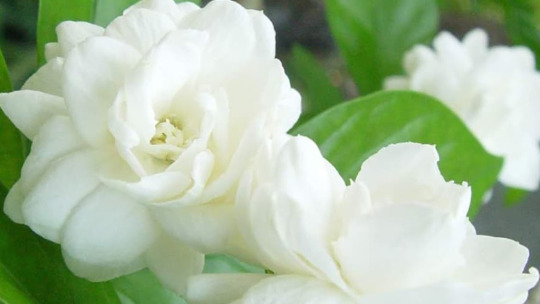
Arabian jasmine flower
This Arabian jasmine flowers are bright white, double layered, tubular, lobed oval flowers contain 9 to 10 petals has sweet & strong fragrance throughout your garden. Flowers contains two stamens with very short filaments.
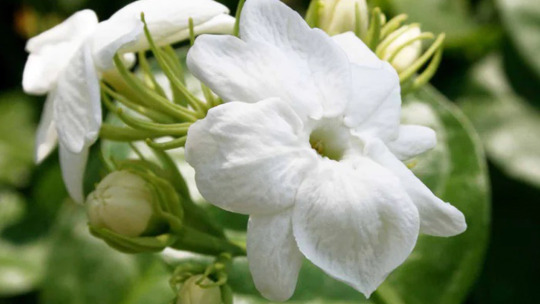
Arabian jasmine plant
Like all jasmine plant varieties, this plant is perennial evergreen with thin woody branches. Arabian jasmine plants are small shrubs with lush foliage. And its climber vines reach up to the height of 25-30 cm & spreads wide 10-20 cm. Arabian jasmine plants are native to Asia, grows healthy & excellent in all climatic conditions of India.
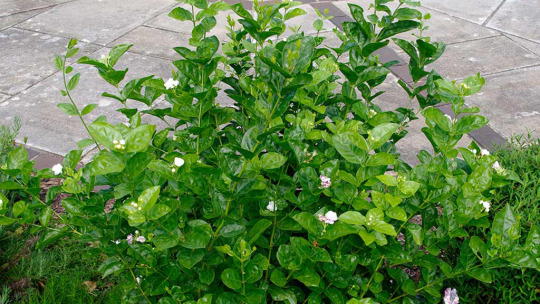
Jasminum sambac
Arabian jasmine flower has scientific name Jasminum sambac spreads rapidly as shrub or veins with upright habits. Jasminum sambac is popularly called as “Belle of India” meaning Queen of India. Presence of Scent fragrance refreshes the mind & environment.
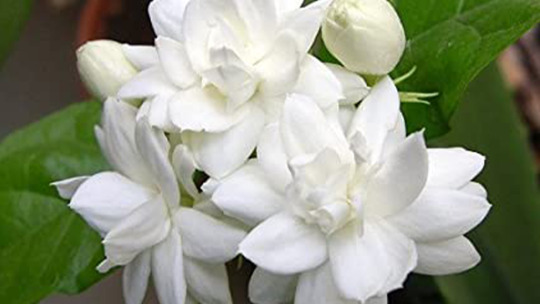
How to grow Arabian jasmine
Arabian jasmine plants are considered as‘megastar of garden’. This can grow well in garden areas such as home garden & terrace garden. This plant can be grown in grow bags, pots or any suitable container.
Flower farmer’s most cultivated plants are Arabian jasmine plants with high yield & it is most suitable for scent preparation purposes.
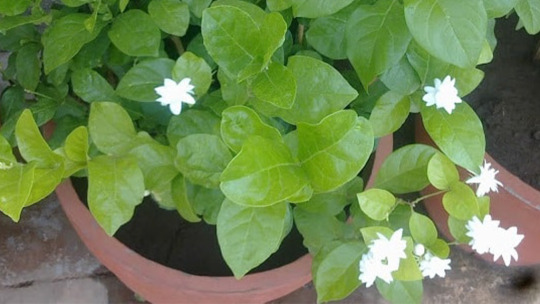
Soil
Arabian jasmine plants prefer to grow in loose, loamy, well-drained soil with some organic matter content mostly prefers to grow in acidic to slight acidic soil of pH of 4.5 to 6.9.
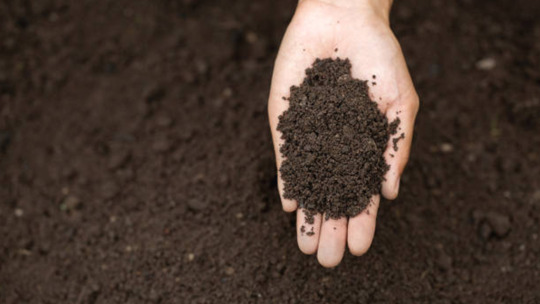
Sunlight
This plant requires ample of sun light i.e. is direct sun light of 4-6 hours. It can also tolerate in shade.
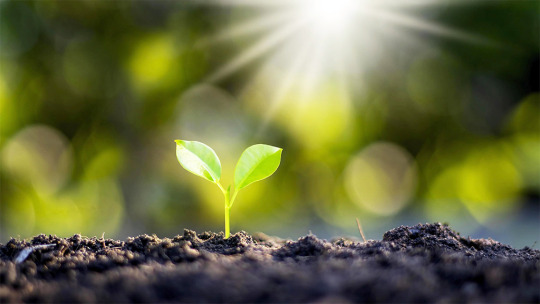
Temperature
Ideal temperature for Arabian jasmine plant is 85-90 degree Celsius during day time & in night time 70-80 degree Celsius.
Watering
Moderate to average water application is given. Alternate day water application but not to make the soil soggy & wet. Because overwatering may lead to root rot diseases. Avoid watering in winter seasons(November-December).
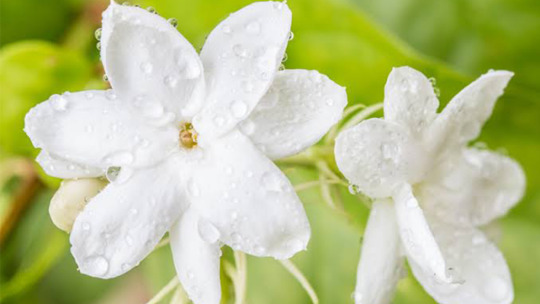
Fertilizer
Application of organic fertilizer such as vermicompost, cow manure or goat manure, Groundnut cake powder for nitrogen enhancement & to increase soil fertility.
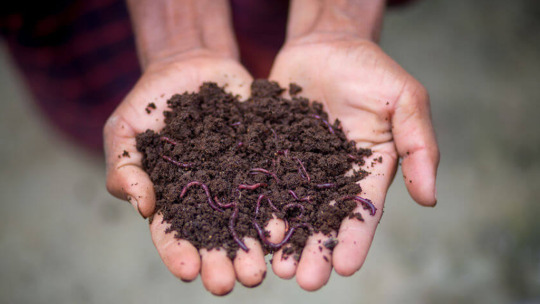
Organic fertilizer for pest attack
Application of Neem oil, Bio-Npk, Steamed bone meal once in three months. Not to over fertilize the plants. Application of organic fertilizer given only in required quantity. Prefer to grow plants by using organic fertilizer.
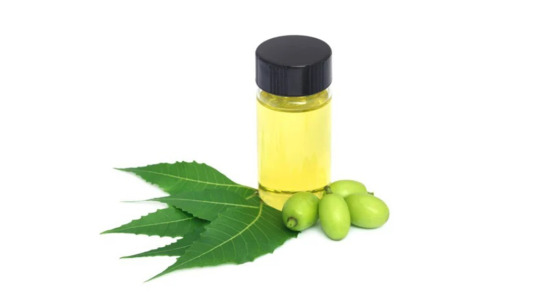
Repotting
This plant does not like to grow in too large pot, because it may lead to water stagnation. Select the pot of 3-4’’and once if the plant grows large. Transfer the plants to big size pot compared to last one but most importantly not to damage the roots.
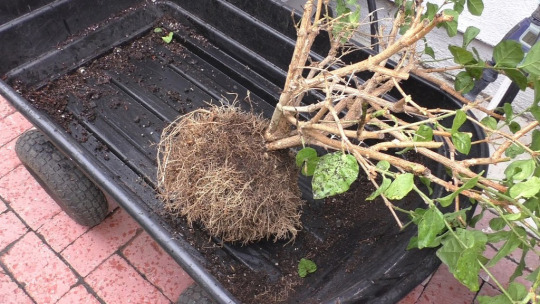
Pruning:
Prune the Arabian jasmine plants in winter, because flower blooming will be less compared to other seasons.Trim the old, diseased and matured plant parts to encourage fast growth in plants.

Harvest:
To get fresh flower yield, fully developed & unopened flower buds are hand-picked in the early morning or late evening. Probably harvesting time starts from 6 months after planting.
Life time of Jasmine plant:

Yield:
Expected average yield of about 800-900 kg of flowers per acre. In houseplant we can expect about 1kg of flower yield.
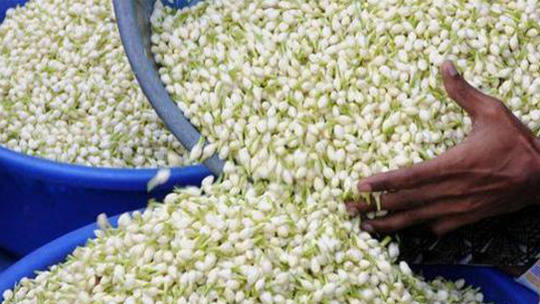
All and above grow plants good and healthy by using organic & traditional method of practices to grow plants. Go green and make our environment clean & green.
Blog compiled by : Santhionlineplants
#ARABIAN JASMINE#Arabian Jasmine flowers are king of fragrant flowers. Jasmine are of more than 200+ varieties around the world. But Arabian jasmine occupie#Jasmine flower#Arabian jasmine flower#This Arabian jasmine flowers are bright white#double layered#tubular#lobed oval flowers contain 9 to 10 petals has sweet & strong fragrance throughout your garden. Flowers contains two stamens with very short#Arabian jasmine plant#Like all jasmine plant varieties#this plant is perennial evergreen with thin woody branches. Arabian jasmine plants are small shrubs with lush foliage. And its climber vine#grows healthy & excellent in all climatic conditions of India.#Arabian jasmine flower plant#Jasminum sambac#Arabian jasmine flower has scientific name Jasminum sambac spreads rapidly as shrub or veins with upright habits. Jasminum sambac is popula#jasminum sambac#How to grow Arabian jasmine#Arabian jasmine plants are considered as‘megastar of garden’. This can grow well in garden areas such as home garden & terrace garden. This#pots or any suitable container.#Flower farmer’s most cultivated plants are Arabian jasmine plants with high yield & it is most suitable for scent preparation purposes.#arabian jasmine growth#Soil#Arabian jasmine plants prefer to grow in loose#loamy#well-drained soil with some organic matter content mostly prefers to grow in acidic to slight acidic soil of pH of 4.5 to 6.9.#soil#Sunlight#This plant requires ample of sun light i.e. is direct sun light of 4-6 hours. It can also tolerate in shade.#Temperature#Ideal temperature for Arabian jasmine plant is 85-90 degree Celsius during day time & in night time 70-80 degree Celsius.
11 notes
·
View notes
Text
Data Files: The Local Flora
An external record of the varied plants found in the regions surrounding you. Logs will be updated when new plants are encountered.
Current entries: - Worm grass - Bubble seed - Cherrybomb - Flarebomb
Worm grass
Old food crops, run rogue after accumulating several dozen mutations. Once, they were a hyper-engineered strand of wheat, designed to persevere through extreme temperature fluctuations, heavy rains, freezing, drought, among other severe weather conditions. At some point down the line, however, possibly owing to the poor nutrient value of the soil they were growing in, they became carnivorous, actively seeking out nearby movement in hopes of edible creatures.
Each singular strand is one organism, but their roots stitch together into a complex web that enables nutrient sharing; if a small cluster of worm grass latches onto a creature, more will be attracted to drag it down, and the whole patch benefits from the sustenance. The grasses also differentiated into several distinct strains, with yellow worm grass being the most genetically similar to the original wheat strain. It is also the least aggressive, though its height and immense denseness make it dangerous to traverse still. Red worm grass and blue worm grass, in decreasing magnitude of height but increasing magnitude of aggressiveness, diverged from the main strain some indeterminate amount of time ago. Blue worm grass in particular is an aggressive colonizer of the areas around it, and will voraciously consume structures in search of more food. They all still, however, retain their original nutritional value, if they are neutralized by severing them from their roots.
Bubble seed
An old cultivar selected for the subtle beauty of its flowers. Colloquially referred to as bubble fruit for the unique feature of its seeds, these plants were occasionally planted by the people of old as a recreational activity. The flowers produced are small, bearing a delicate fragrance, and range from hues of light lavender to a deep violet. Most variants are biennial, but when seed production is incomplete or intentionally obstructed, the flowering cycle will lengthen, allowing for more enjoyment of the modest blooms.
The seeds have a double seed coat, from which their colloquial name is derived: when placed in water, the external seed coat draws water into its desiccated cells, causing the seed to swell to up to six times its original size. This process makes the seed more enticing to critters and protects the plant embryo as the seed is consumed. When not hydrated, the seed is extremely tough, and several cases of deliberate injury with bubble seeds have been reported. The swollen outer seed coat is surprisingly nutritious, though not as much as traditional food sources; it is a possible source of nutrients when food stores are running low.
Cherrybomb
An esoteric spice occasionally cultivated by your creators. The colloquial name of 'cherrybomb' came about from its appearance, which superficially resembles an extinct type of primal flora, and its mildly explosive quality. It was never popularly grown by the people of old for its beauty; its flowers, though large, are largely invariant without a notable fragrance, and also decay quickly. Rather, it was chosen for its ability to add heat to a dish, a quality that its perennial growing cycle compliments. A single seed pod yields upwards of twenty seeds, which can be roasted and then ground up to be used as a garnish in dishes. More adventurous chefs would cook the seeds whole, allowing their naturally pungent flavors to seep into the other ingredients.
Both the seeds and the seed coat produce a volatile chemical as a means of self defense and for propagation. At rest, the compound is inert and stable, but when enough energy is provided, whether by means of mechanical stimulation or the input of heat, it rapidly oxidizes in the presence of oxygen, expanding and releasing heat. This expansion causes the seed pods to pop open, emitting loud crackling in the process; the seeds are then propelled away from each other. Reportedly, this made cultivating cherrybombs difficult, contributing to their poor popularity.
The chemical secreted by the seeds and seed pods is mildly toxic, often causing symptoms of digestive distress such as diarrhea and intestinal cramping in low doses. It is neutralized by cooking the seeds, though care has to be taken to raise the temperature slowly so as not to set off their explosive nature. In high doses, regardless of whether the compound has been neutralized, it accelerates cell apoptosis due to chemical irritation, often leading to necrotic tissue accumulating where it was applied. Cultivation of cherrybombs was thus strictly regulated to prevent its use as a biological weapon, and there are various guidelines around safe consumption of its seeds.
Flarebomb
A plant in the same genus as cherrybombs. Its colloquial name takes after its more abundant sister, both because it was discovered after cherrybombs and because its applications are limited. This is exacerbated by its unusual growth requirements: flarebomb plants wilt in direct sunlight and prefer gentle shade. It also, unlike its sister, has an annual life cycle, so it was often only cultivated by the most avid of gardeners.
Its seed pods are much more studied than the rest of the plant. Similar to cherrybombs, the seed pods and seeds of flarebombs secrete a chemical that, when sufficient energy is provided, react to produce heat. However, the predominant compound produced by flarebombs is bioluminescent; the heat released is a byproduct of the oxidation of this compound. The light produced when the seed pods are shaken is variable over a range of deep purple to a light blue-green, but most commonly shines a vibrant blue. The seed pod itself is remarkably translucent, allowing the light produced from the seeds to pass through when gently shaken. Older children often enjoyed using the seed pods as a portable light source.
Notably, the reaction occurring in flarebombs is sparingly reversible, allowing a single seed pod to be used for an appreciable number of days, but eventually all of the compound is converted to its non-bioluminescent form. This is greatly accelerated by puncturing the seed pod and allowing oxygen to react directly with the seeds.
#data files#innocence won't save you#rain world#i figured it was probably about time to split the fauna and flora post#i wish i could provide hyperlinks to sections in this post but alas#the limitations of tumblr#unless there's actual html for that lmao#i can't be bothered though#remember these logs are also on ao3!
11 notes
·
View notes
Note
👽 AUs 🤸♀️ OCs 📶 crossover ships 🗝 selectiveness in the RPC
opinion on…
👽 AUs
i’m pretty restrained about setting up AU verses, mostly because, like, gestures at time does this. if i give myself an inch i will take a mile and while that’s great fun for writing longfic, it can become a giant headache when it comes to RP because most people aren’t here to do serious expansive thematically-grounded worldbuilding lmao. so presently i only have one formal ‘AU’ verse that isn’t even properly an AU, it’s just vaguer for the purpose of not godmodding other salems or summers. and then i have a grimm!oz AU cooking in the back of my head and i’m perennially tempted to just make a TDT-lite AU verse here (<- cinder-goes-to-beacon AU, for the uninitiated) which i’m Valiantly Resisting.
🤸♀️ OCs
i love them. writing them and writing with them and reading about them. in the event i ever lose the aforementioned TDT-lite verse battle with myself there are like… seven or eight OCs that i would add here as secondaries and three of them are characters i’m really tempted to sketch out canon verses for here. and well, longfic. i have hundreds of OCs bfrjdhk
in particular i’m really into the type of OC that sits in like… the margin of the lore. briar @hopeandharmonizing comes to mind as a good example, like, you take a piece of lore and extrapolate or expand on it in a new direction to end up with something that isn’t like anything in canon but also feels seamlessly like part of the world. it’s a cool way to flesh out the fictional world and often you end up in super interesting places.
📶 crossover ships
shipping in general isn’t of particular interest to me—i like ships that are compelling thematically and narratively and fandom shipping culture is… really not my speed—but the flip side is i evaluate canon / oc / crossover ships by exactly the same criteria and in the context of RP, which is by nature unserious, i think it’s a bit silly to act like there’s a material difference between a crossover ship versus a canon-verse ship.
like… the difference between a narratively incoherent canon ship and a random crossover ship is largely semantic; likewise, a well-developed crossover (or oc) ship can be equally as grounded in theme and as narratively compelling as a good canon ship.
🗝 selectiveness in the RPC
honestly i think the fact that ‘selectivity’ is something that needs to be codified in blog rules at all (and that there’s discourse about it!) is a bit of an indictment of the community culture. it should go without saying that people will only write with the people they want to write with. this should be the presumed default and a non-issue. that some people are less “”selective“” than others is like… yeah? duh? some people are more outgoing than others. water is wet. come on.
2 notes
·
View notes
Text
youtube
You don't always need a farm to grow your own food. Edible landscapes and food forests can be grown and enjoyed right in your own backyard. With a little knowledge, trial and error, and continued practice, you can learn to grow all sorts of wonderful fruits and vegetables even in the middle of the suburbs.
Start growing your own food forest with a pack of heirloom seeds: https://amzn.to/3HSnT7z
Watch more from Justin: / herballyfstyl
Don't forget to LIKE, COMMENT, SUBSCRIBE, & SHARE!
BEHIND THE SCENES: https://www.patreon.com/PARAGRAPHIC
PRODUCTS & SERVICES: https://paragraphic.io/
AMAZON STOREFRONT: https://www.amazon.com/shop/paragraphic
BOKEH SUPPLEMENTS: https://bokehrola.com/
JOIN THE MULTITUDE: https://www.multitude.io
FOLLOW US @theparagraphic https://www.instagram.com/theparagrap...
LEARN MORE AT https://theparagraphic.com/
What is a food forest?
A food forest is an edible landscape that is modeled after a natural forest ecosystem.
A food forest is an excellent way to produce a large quantity of food with minimal effort. Once established, a food forest will require little to no maintenance and will provide an abundance of fresh fruits, nuts, and vegetables throughout the growing season.
A food forest can be created on any size piece of land, from a small urban backyard to a large rural property. The key to success is to design and plant the food forest in such a way that mimics the structure and function of a natural forest ecosystem.
The benefits of establishing a food forest are many. In addition to providing an abundance of fresh, healthy food, a well-designed food forest can help to improve soil quality, increase biodiversity, and provide habitat for wildlife.
Where can you grow a food forest?
A food forest can be grown in any backyard, regardless of size. The key to success is starting with a plan and design that takes into account the specific conditions of your yard.
The first step is to perform a site analysis, which will help you understand the microclimates, sunlight, soil type and drainage in your yard. With this information, you can select the right plants for your food forest.
Once you have a plan, the next step is to prepare the soil. This may involve adding amendments to improve drainage or adjusting the pH level. Then, it's time to start planting!
When selecting plants for your food forest, consider both annual and perennial crops. Annuals will provide a quick harvest, while perennials will provide a longer-term food source. Be sure to include a mix of fruits, vegetables, nuts and herbs in your planting scheme.
As your food forest grows, it's important to keep an eye on weeds and pests. Hand-pulling or using mulch can help control these problems naturally. With a little care and attention, your backyard food forest will thrive!
Assuming you have the space, there's nothing more gratifying than growing your own food. And, while a traditional vegetable garden has its merits, why not go big and plan for a food forest? With a little bit of planning (and some hard work), you can create a backyard oasis that will provide you with an abundance of fresh fruits and vegetables for years to come.
Here are a few tips to get you started:
1. Choose the right location. Make sure you pick a spot that gets plenty of sunlight and has well-drained soil.
2. Select a variety of plants. When it comes to fruit and vegetables, the more the merrier! Plant everything from berries and grapes to tomatoes and potatoes.
3. Give them room to grow. Remember, most fruits and vegetables need room to spread out so don't plant them too close together.
4. Be patient! It takes time for a food forest to reach its full potential but it will be worth the wait!
Growing your own fruit and nuts can save you money at the grocery store, and it’s a great way to get outdoors and enjoy some fresh air while you’re tending to your garden. Food forests can also provide habitat for wildlife, and can help to purify the air and water in urban areas.
• • • • • • • •
ABOUT PARAGRAPHIC:
Handcrafted documentaries featuring artisans of all trades. We are filmmakers who tell the stories of creators, makers, entrepreneurs, and artists. The ones who have committed everything to their craft. From garage bakeries and mushroom farms to backyard aquaponics and innovative fabricators, these stories will take you behind the brand and show an inside look at the people who make it happen.
-Of the earth, from the plough
#foodforest #ediblelandscape #garden
#PARAGRAPHIC#solarpunk#food forest#garden#gardening#food#plants#edible landscaping#urban gardening#food not lawns#grow food#Youtube
5 notes
·
View notes
Text
Boutonnière Ideas for Any Wedding Style
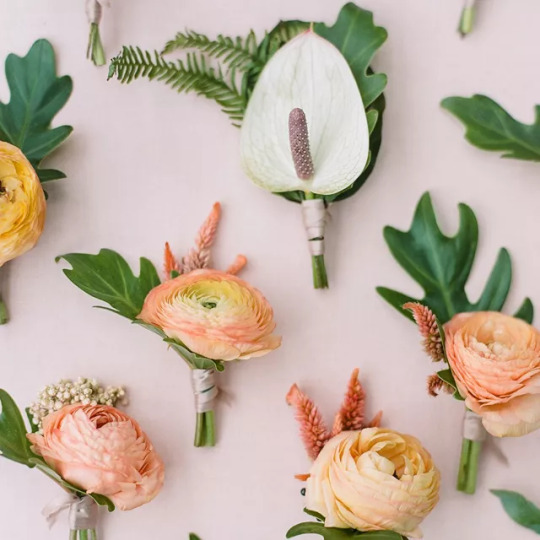
Just about any bloom will work for the wedding boutonnière, but why stick with predictable picks? Luckily, there's no shortage of ideas. But how do you pick the perfect wedding boutonnière that will earn your seal of approval and still feel like a cohesive part of your floral design?
Start with the color: White, green, and yellow are all popular shades. Another great way to balance out a boutonnière is with the addition of bold greenery. Fresh herbs, leafy greens, or a modern succulent are all great additions to softer-hued flowers. Or go with one large succulent, a cluster of greens or berries, or a barely there off-white cluster of nontraditional wedding flowers—we like perennial astilbe or clematis—for a look that expresses a more modern style.
In an effort to help you select the perfect boutonnière, we rounded up some great ideas that you're sure to love.
Rosebuds and Bunny Tails

Red and white rosebuds totally pop against this gray, acutely patterned suit jacket without clashing with that funky purple pocket square. We love how the addition of feathery dried grasses and fluffy bunny tails completely refreshes this otherwise traditional rose boutonnière.
Blue Grape Hyacinths

There's nothing more evocative of a brilliant summer day than this cluster of blue grape hyacinths wrapped in a natural, bleached burlap. Best of all? The flowers were picked up from the local flower market the day before this intimate waterfront wedding.
Dried Grasses and Chrysanthemum

Now, this is posh with an organic boho twist. The oh-so sophisticated formal tux gets a brush of nature with a boutonnière of bleached, dried grasses and chrysanthemums. We can't help but drool over the color palette.
Flag Pins and a Single Rose
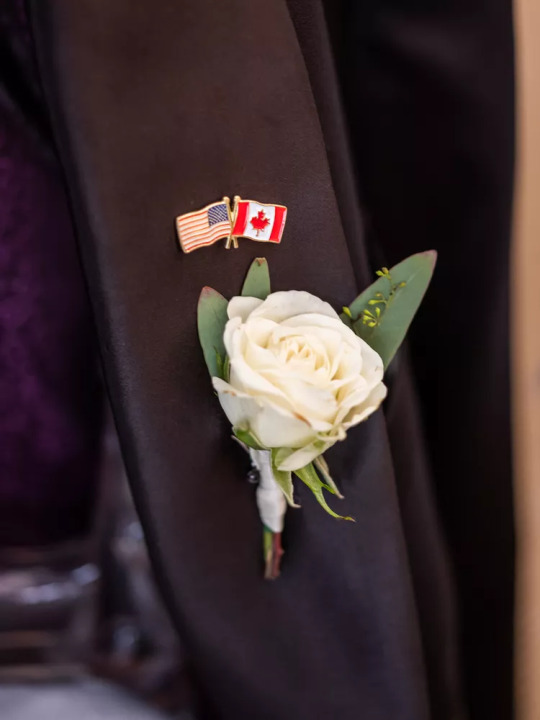
Let your flags fly and wear your national pride on your, er, lapel on your wedding day. This white rose boutonnière is crowned with an American and Canadian flag pin representing the newlyweds' separate nationalities coming together.
Scabiosa and Rosemary
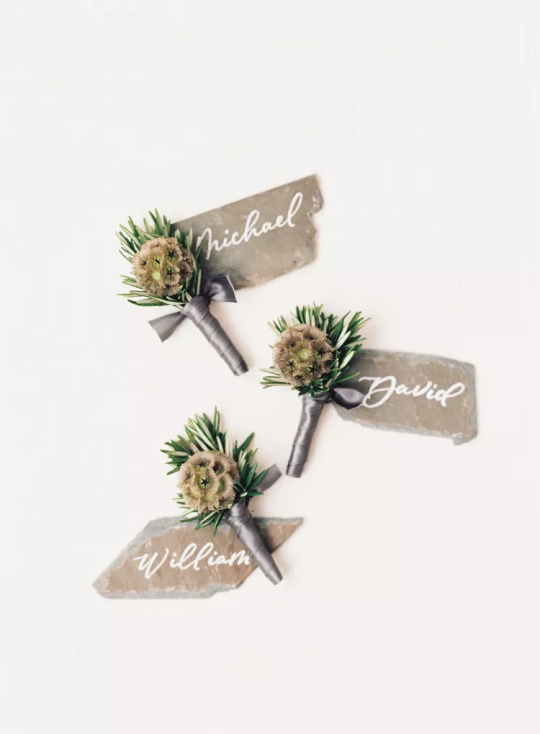
These playful bundles present an unexpected composition. Lollipop scabiosa and fragrant rosemary come together in the most elegant way.
Green Hellebores and Privet Berries
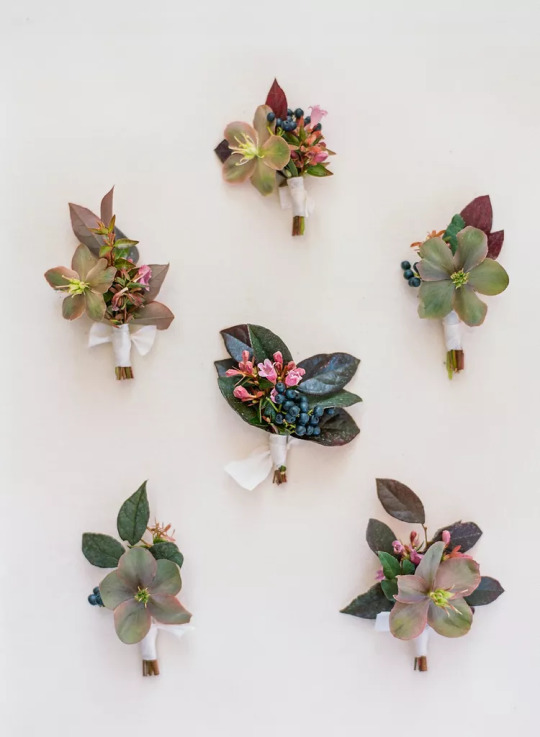
These boutonnières of muted green hellebores, reddened foliage, and tiny privet berries encapsulate all the romance of an autumnal wedding. We love that each tiny posy keeps with the uniformity of the bunch but takes on a unique look all its own.
A Garden Rose With Tuberose and Delphinium

Now here's a romantic boutonnière. A rust-hued garden rose is framed by pale pink and cream tuberose and delphinium for a color palette that harmonizes beautifully with the pale tuxedo.
Pampas Grass and Greens

An inky tux with a black shawl collar can be difficult to accessorize. This bright pampas grass boutonnière contrasts exquisitely in both texture and tone without getting lost in the mix.
Purple Clematis

Purple and blue are far from your traditional nuptial color palette. But this purple clematis boutonniere and gray-blue suit certainly make a case for the combo.
Berry and Gum Leaves

A simple boutonniere comprised of berry, gum leaves, and additional greenery adds a fresh touch to this black-and-white ensemble. How sweet is that twine wrapped around the stems?
Mums With Dried Grasses and Ferns

We're definitely digging this combination of bold, spicy hues with all-black attire and turquoise accents. The rich boutonnière gets its character from sunset-hued mums, dried grasses, and ferns.
Ivory Rose and Rosemary

Roses and rosemary seem like they would go hand in hand, which is why we're surprised we haven't seen more of them together. This herbaceous medley consists of a single ivory rose and clusters of rosemary all wrapped in matching satin ribbon.
Astilbe Tied With Ribbon

Hello, texture! Fluffy and poignant astilbe is backed by greenery and held tightly with ribbon in this boutonnière. Check out how the pink ribbon picks up on the slightest bits of pink in the blooms.
Lavender and Olive Leaves

Fairy-tale nuptials in the French countryside clearly call for an equally enchanting boutonnière. This storybook design pairs sprigs of heavenly lavender with olive leaves and ties it all together with frayed linen in the palest shade of blue. Et voilà!
Garden Roses and Hypericum Berries

Pale green blooms and hints of white just exude "alfresco wedding." This boutonnière consists of locally foraged botanicals, garden roses, and hypericum berries in the most revitalizing of hues.
Mini Tulips and Herbs

Who doesn't instantly smile when looking at this jubilant little mix? Here, happy yellow tulips and rosemary come together in the most vivacious boutonnière.
Pieris and Dried Grasses
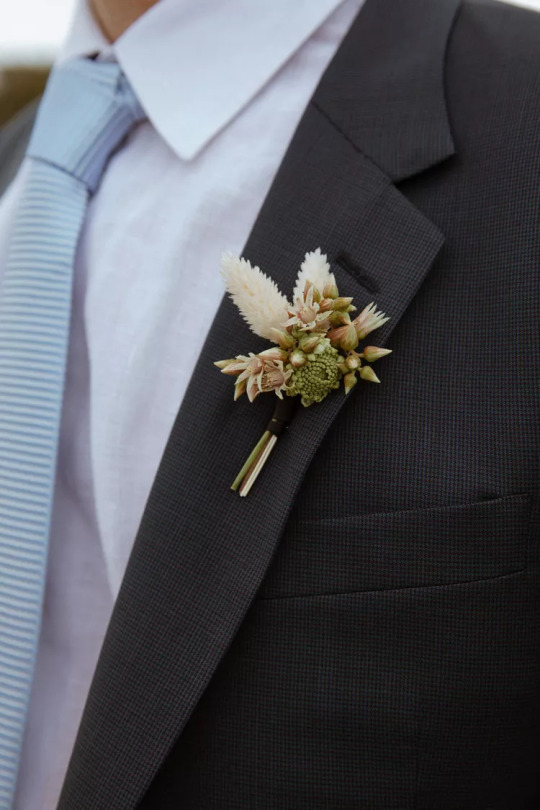
This charcoal suit takes on new life with a boutonnière of pieris and dried grasses. The sea-inspired textures and muted tones are a picture-perfect fit for a boho coastal wedding.
Succulent With Snowberries

If soft, cool tones are taking up real estate on your wedding mood board, you'll want to take note of these pale blues, soft grays, and powdery greens. This succulent boutonnière is accented with yellow snowberries and dusty miller leaves for a truly unique design.
Wintry Roses and Greenery
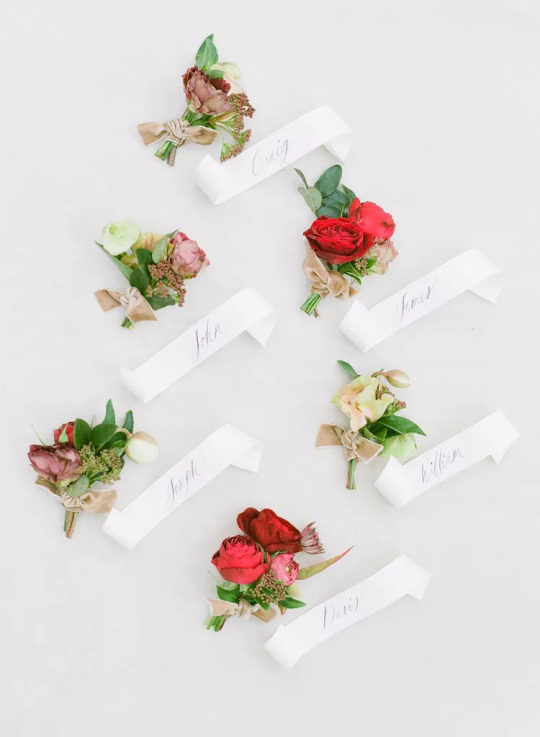
Think winter-wedding chic without all the obvious, seasonal connotations. These boutonnières of plum, dusty purple, and cranberry roses with vibrant greenery completely nailed the aesthetic.
Hydrangea Blossoms, Berries, and Acorns
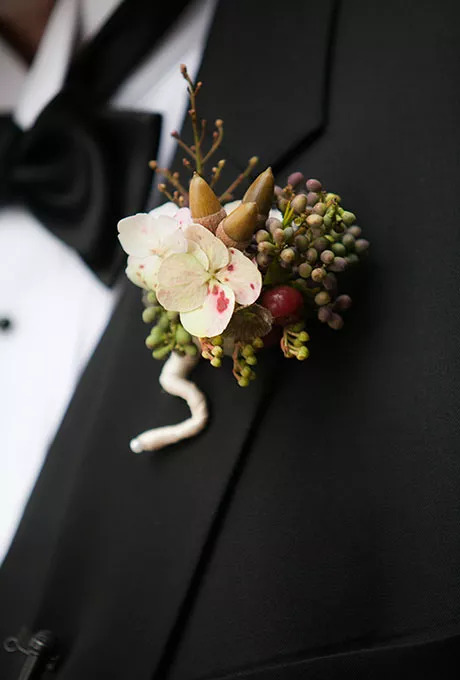
A white and green boutonnière comprised of hydrangea blossoms, berries, and acorns has all kinds of unexpected textures. And honestly, how sweet are those tiny acorns?
Off-White Roses

This blue striped suit and polka-dot bow tie need little extra in the way of accessories. A classic boutonnière comprised of off-white roses and extended stems finishes off the look nicely.
Rustic Thistles

We absolutely adore a little rustic touch to an otherwise formal fête. This blue thistle and rosemary boutonnière is simple and eye-catching.
Mustache Pin With Dried Wheat

What's a wedding without a little personality? This harvest-themed boutonnière of dried wheat and pastoral flowers gets a little pizazz with a mustache pin.
Peach Ranunculus and Silver Brunia

This boutonnière of a single peach ranunculus and silver brunia highlights the fact that peach tones and silvery greens are quite complementary. We especially like the unique, duo-chrome approach to ribboning off the medley in silver and black.
3 notes
·
View notes
Text
Are you looking for the best plant nursery in Noida? Then look no further than Noida Greens!

Noida Greens is the best plant nursery in Noida, offering a wide variety of plants and gardening supplies. Their knowledgeable staff and excellent customer service make them the top choice for anyone looking to start or add to their garden.
Are you looking to start or add to your garden? Noida Greens is the best plant nursery in Noida. They have a wide variety of plants and gardening supplies to choose from, as well as knowledgeable staff and excellent customer service.
Noida Greens offers a large selection of plants and gardening supplies, from exotic flowers to rare succulents. Their knowledgeable staff can help you find the perfect plants for your garden and provide expert advice on how to care for them. They also provide a variety of services, such as professional landscape design and installation.
The staff at Noida Greens is friendly and knowledgeable, and they are always willing to answer any questions you may have. They are committed to providing the best customer service possible and will work with you to ensure that you get the right plants for your garden.
In addition to their selection of plants and gardening supplies, Noida Greens also offers educational workshops and seminars. These workshops provide valuable information on gardening and plant care, and they are a Noida Greens is the best plant nursery in Noida, offering a wide selection of plants, trees, shrubs, and flowers. They provide top-notch customer service, quality plants, and delivery services. Their knowledgeable staff can help you choose the right plants for your garden.
Noida Greens is a renowned plant nursery located in Noida, India. They offer a wide range of plants, trees, shrubs, and flowers that are sure to meet your gardening needs. Their knowledgeable staff can help you choose the right plants for your garden.
At Noida Greens, their team of professional horticulturists and gardeners ensure that the plants are of the highest quality and are well taken care of. They have an extensive selection of plants and trees, from ornamental flowering plants to fruit trees. They also have a wide variety of shrubs and flowers, including annuals and perennials.
Noida Greens provides top-notch customer service and delivery services. Their helpful staff can help you choose the right plants for your garden and will provide you with detailed information about each plant.
Noida Greens is the best plant nursery in Noida, offering a wide variety of plants and quality services. They have a wide selection of indoor and outdoor plants, and offer a variety of services including landscaping, delivery, and more.
Are you looking for the best plant nursery in Noida? Look no further than Noida Greens. Noida Greens is the leading plant nursery in the city, offering a wide variety of plants for both indoor and outdoor use. Whether you’re looking for a small potted plant for your home or a larger one for your garden, Noida Greens has the perfect plant for you.
Noida Greens offers a wide selection of plants, from flowering plants to trees and shrubs. They also have a variety of garden accessories, such as pots and planters, to help you create the perfect look for your outdoor space. In addition, they offer a selection of landscaping services, such as lawn care and garden maintenance.
The staff at Noida Greens is knowledgeable and friendly, and they are always willing to offer advice and help you find the right plants for your needs. They also offer delivery services, so you don’t have to worry about transporting your
Source: Noida Greens
2 notes
·
View notes
Text

A Faustian Bargain: Schumpeter's Magic of Monopolies
Railroad iron is a magician's rod, in its power to evoke the sleeping energies of land and water. Ralph Emerson, The Young America, 1844
Industrial policy universally remains the precursor to the take-off of industry whether it was in Britain, America or elsewhere. But a more clinical study reveals how one common denominator emerges in each vignette of such meteoric growth: monopoly rights. On every single occasion across recorded history where a laggard industrializes a prototypical paradigm is espoused. A curated few are anointed to be national champions: (i) the British East India Company and the Hudson’s Bay Company were darlings of economic growth for London; (ii) the Dutch East India Company was the Netherlands’ janissary to brave the high seas; (iii) America chartered the juggernauts of the Pacific and United States Mail Steamship Companies to reconcile the Western frontier with the Atlantic Seaboard; (iv) the triumvirate of Ford, General Motors and Chrysler achieved market dominance at the beck and call of Washington; (v) North American Aviation and Rocketdyne outflanked the Soviets in America’s space odyssey; (vi) Boeing and McDonnell Douglas bestrode the sector of commercial aircraft; (vii) Pan-Am, United and TWA were incubated in mail-route subsidies. In each new venture fraught with prohibitive fixed costs any scalability requires stable revenue. Oligopolies therefore are established to marginalize smaller competitors whose presence are anathema to innovation and swift industrialization.
Industrial policy takes a myriad of shapes and the hegemony via monopoly rights whether by public procurement or other privileges perennially remains the sine quo non of innovation. Quite simply when a company finds themselves awash with capital they are far likelier to adopt state-of-the-art technology in an abbreviated time frame. Yes, legislated favouritism at first blush does appear unjust but it eclipses any other accelerant. If abandoned to the mercies of free markets fast development would be next to impossible. When government dotes on a select few their capital accumulation as de facto monopolists enables them to grow apace. Indeed the long history of industrialization shows it has never been the child of laissez-faire capitalism. In every single instance has there been the presence of government intervention. In America’s industrial firmament the majority of companies have become household names as the direct progeny of tariffs, subsidies or charters. This Hamiltonian philosophy of protecting infant industries against entrenched incumbents from abroad has been a repudiation of Economist Adam Smith’s invisible hand at least in the embryonic stages of growth. So whilst it may be a Faustian bargain of pricing out smaller companies this sacrifice of market liberties heralded a Golden Age.
The magic of monopolies was a force disrupter in the 19th century. What free market purists habitually fail to acknowledge is how the ‘creative destruction’ of a few firms perpetually remains the lynchpin of frenetic growth. The foregoing neologism first coined by Economist Joseph Schumpeter throws into relief how businesses with stable profits when unencumbered by competitors demonstrate a boldness in their expansion. Why? Companies which have amassed a war chest of capital plough their money more liberally into technology, capital assets and vertical integration to preserve their market dominance. For instance the incipient stages of America’s industrial revolution largely hinged on the railroad monopolies sponsored by government as they sought sturdier and cheaper steel at scale. The spillover from this hunger precipitated the adoption of Britain’s Bessemer process whose innovation later transcended rails as the advent of skyscrapers began to inform the skyline silhouettes of cities everywhere. Akin to economic jazz a synergy spontaneously manifested between railroads and steel mills as the rest of American businesses rode the coattails from the attendant rise in productivity. Mass production therefrom implied more tracks, heavier tonnage on those said tracks and the substitution of masonry with steel for buildings.
The externalities from railroad monopolies were many. It is not hyperbole to state America’s formative years were built on the back of railway demand after first being the beneficiary of maritime commerce and state-sponsored infrastructure like inter alia canals, ports and lighthouses. In the absence of these monopolies the fast cadence of industrialization would have been stillborn devoid of the springboard purveyed by government. Lawmakers took great pains to foster this infrastructure by being guarantors of stable profits whose knock-on effect conduced to stable markets for steelmakers. The Gilded Age then is the legacy of this synergy wrought by the paternalism of industrial policy amidst the heyday of wealth and urbanization. Contrary to conventional wisdom the robber barons of this era did not manifest ex nihilo by bootstrapping their own riches. Andrew Carnegie’s steel empire, John D. Rockefeller’s oil kingdom, Cornelius Vanderbilt or Jay Gould’s railroad fortunes all derived from real estate allotments on public land, eminent domain authority, route monopolies, mail contracts, direct subsidies and more. Unbeknownst to the layman these industry captains were not entirely self-made. In a social bargain of a utilitarian nature a few rent-seeking companies would become handmaidens to America’s exceptionalism.
Henceforth no longer would the nation be an agrarian confederation but rather an industrial heavyweight. Commerce could be swiftly conducted over savage terrains and forbidden plains in a matter of days not weeks. The achievement of industrial policy for railroads was to truncate time whereby America industrialized in less than half a century. The real muscle behind the Union’s Manifest Destiny was this lattice of iron crisscrossing the nation. Railroads thus revolutionized production insofar as this infrastructure was a fillip to the transportation of freight and people where things organized themselves organically between the merchant class in bustling cities and the farmers and miners in far-off counties. All that was required to jumpstart this growth was the seed of industrial policy bestowing privileges upon a few business interests. By 1900 America’s production exceeded that of Great Britain which hitherto was lauded as the world’s workshop (Wright 1990:652). Where maritime commerce might have been nation-building the humble railroad was itself empire-building. Such continental integration through rail links across a landmass larger than Western Europe spawned new epicentres of business overnight. This economic miracle was unfathomably quick.
0 notes
Text
What type of herbicide will get rid of Heartwing sorrel?

Did you know that over 70% of lawn care professionals consider Celsius WG to be one of the most effective herbicides for controlling invasive weeds, including the notorious "Heartwing sorrel"? This surprising statistic highlights the significant impact that Heartwing sorrel can have on lawns and gardens, and the importance of effective control measures.
Heartwing sorrel, also known as Rumex hastatulus, is a perennial weed that is native to North America. It is characterized by its distinctive heart-shaped leaves and reddish-brown flowers, which bloom in the spring and summer months. While it may be an attractive addition to a wildflower garden, Heartwing sorrel can be a significant nuisance in lawns and gardens, where it can outcompete desirable plants for water and nutrients.
One of the most significant challenges in controlling Heartwing sorrel is its ability to spread quickly and easily. The weed produces thousands of seeds per plant, which can be dispersed by wind, water, and animals. This means that even a small infestation can quickly become a major problem, requiring significant time and effort to eradicate.
In addition to its ability to spread quickly, Heartwing sorrel is also highly adaptable, and can thrive in a wide range of environments. It can grow in full sun or partial shade, and can tolerate a variety of soil types and moisture levels. This makes it a formidable opponent for lawn care professionals and home gardeners, who must be prepared to use a range of strategies to control its growth.
When it comes to growth control or eradication, there are several options available. One of the most effective methods is to use a selective herbicide, such as Celsius WG, which can target the weed without harming desirable plants.
-> Get **Celsius WG** For Warm Season Turf Herbicide here.
This herbicide is particularly effective against Heartwing sorrel, and can be used to control infestations in lawns, gardens, and other areas.
In addition to using Celsius WG, there are several other strategies that can be used to control Heartwing sorrel. These include physical removal, such as pulling or digging up the weed, and cultural practices, such as improving soil quality and using competitive groundcovers. However, these methods can be time-consuming and labor-intensive, and may not be effective in large-scale infestations.
Overall, Heartwing sorrel is a significant weed that can have a major impact on lawns and gardens. However, with the right strategies and tools, including Celsius WG, it is possible to control its growth and prevent it from becoming a major problem. By understanding the characteristics and growth habits of this weed, and using effective control measures, lawn care professionals and home gardeners can keep their outdoor spaces healthy and beautiful.
#Heartwing sorrel#weeds#herbicides#weedcontrol#lawncare#weedkiller#weedmanagement#weedidentification#weedremoval#weederadication
0 notes

